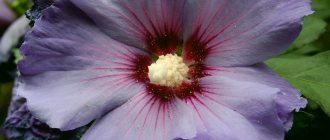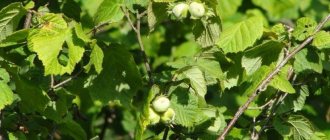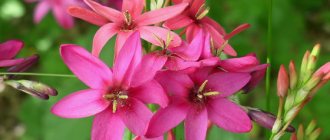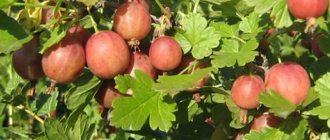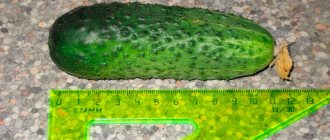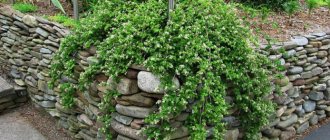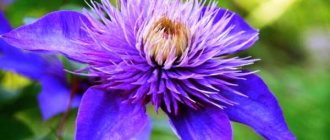General information about Manchurian walnut
The natural distribution area of the Manchurian nut is in the Far East, Northern China, and the Korean Peninsula.
It grows mainly in mixed oak-maple forests, preferring proximity to larch, pine, cedar and other coniferous species. The Manchurian nut in its cultivated form grows and forms crops on the Solovetsky Islands, in the Leningrad, Vologda, Moscow and other regions of Russia. In our region, many summer residents successfully grow this miracle nut.
The Manchurian walnut is similar in appearance to the walnut, but there are also distinctive features. The leaf blade is also complex, imparipinnate, but larger than that of the walnut, reaches a length of up to 1 m, contains 7-19 smaller leaflets (10-20 cm in length), jagged along the edge, with a pointed tip.
The nuts are located on branches in 2-7 pieces, smaller than a walnut, with a very dense shell, oval-pointed towards one end.
The young bark is light gray, smooth, darkens with age and becomes black in places. When planting seedlings, the first harvest is formed in the 4th year, and with seeds - in 7-8. The first years it grows very quickly. The increase is 1-2 meters. An adult plant can withstand frosts down to -50 degrees.
Male flowers and female flowers:
Photos from open sources.
Nut fruits:
Photos from open sources.
Manchurian walnut is a monoecious plant that produces separate male and female flowers.
Male ones - in the form of long black earrings; they bloom simultaneously with the buds opening. The female ones are represented by few-flowered small racemes. They are pollinated by the wind. Flowering occurs in April-May. When the leaves turn yellow, the fruits are suitable for harvesting, this is the 2-3rd decade of September.
Manchurian nut is a light-loving crop, not afraid of winds, but sensitive to drought. Propagated by fruits and ready-made seedlings.
The planting site should be sunny, not shaded by tall trees. Walnut grows well in low places, but the soil must be fertile. Given the deeply penetrating root system with a large branched root, seedlings should be planted away from buildings. If several trees are planted in a row, then holes for seedlings are marked every 10-12 m.
Planting of seedlings can be done in September or April. The planting hole must be prepared with a depth of at least 80-100 cm, and a volume exceeding the root system of the seedling. We lay drainage at the bottom of the hole, under which you can use broken brick, crushed stone and other material. Place a layer of soil to cover the drainage and part of the planting hole. If the soil is depleted in nutrients or dense clay, then we prepare a planting mixture - mix the top layer of soil in the planting hole with humus, turf and sand in the appropriate parts 4:2:2:1. Add 20-40 g/pit of superphosphate and potassium fertilizer. Instead of potash fertilizers, you can add a glass of wood ash. Mix the prepared mixture well.
Photos from open sources.
We place the seedling in the center of the hole and immediately tie it to a peg. We partially fill in the soil mixture, carefully fill a bucket of water and after absorption, add the rest of the soil, press it around the stem. Add another 0.5-1.0 buckets of water.
We mulch the soil around the trunk with peat, mature compost, and healthy foliage.
For the winter, we insulate the seedlings, since at a young age the tips of the branches can freeze. For insulation, we wrap the trunk and lower branches with burlap or non-woven material and protect it from rodents with a net. We dig the mesh into the ground and trample it around. In winter, after snowfalls, we repeat trampling to prevent mice from making passages in fresh snow.
Walnut is a moisture-loving plant, and therefore the soil must be kept constantly moist in the first year. We water 2-3 times a month without flooding the soil.
In years 2-3, we reduce the frequency of watering to 5-7 times per season, and in subsequent years, watering in the summer season is carried out once a month. After watering, the soil must be loosened, simultaneously destroying weeds, and mulched. In the 4th year the tree blooms and can produce its first harvest.
Throughout this period, caring for young trees includes fertilizing with phosphorus-potassium fertilizers, which are applied once during the growing season, preferably during the period of fruit formation (June).
The walnut tree needs annual digging at the level of the outskirts of the crown. Mature trees can tolerate short-term drought and temporary flooding of the root system. To protect young trees from sunburn, do not forget to regularly clean the trunk and skeletal branches with lime mortar.
Hazelnuts in the Urals, planting and care
Many summer residents in their summer cottages, even in the harsh climatic conditions of the Urals, successfully grow various exotic crops. Such plants include hazelnuts, a fruit-bearing deciduous shrub. Some varieties of hazelnuts grow as short trees. We will tell you how to grow hazelnuts in the Urals, as well as the methods of planting and caring for this crop later in the article.
Hazelnuts in the Urals: characteristics of the culture
Before getting acquainted with the method of growing the crop, let’s consider the main characteristics and distinctive features of hazelnuts:
- The height of the bush culture can reach 4-5 meters.
- The leaves on hazelnut shoots are oblong, oval in shape and dark green in color.
- The crop bears fruit with edible nuts that have an oblong shape and a brown shell.
- The fruits appear on the bush at the end of August.
- Hazelnut is a monoecious, dioecious crop.
- A tree or shrub bears fruit 4-5 years after planting.
- The fruit nucleolus consists of two cotyledons.
- Due to the peculiarities of the climate of the Urals, the hazelnut bushes planted in this area bear fruit rather sparingly.
- The largest harvest from the bush can be harvested in the 8-14th year of the crop’s life.
Thanks to new approaches in agricultural technology, it has become possible to grow heat-loving crops in more difficult conditions. In the southern regions of the Urals, Chelyabinsk region and others, the cultivation of grapes, plums, apricots, as well as a cultivated type of hazel - hazelnuts, is actively developing.
The most frost-resistant varieties, such as Tambovsky early and Tambovsky late, Pamyat Yablokova, Ivanteevsky red, give excellent harvests, although they require more careful care, especially in winter. Thus, without covering the male inflorescences for the winter under snow cover, it is unlikely that a nut harvest can be expected.
With proper planting and care, within a few years the planting field will be able to enjoy tasty and healthy nuts. Apart from some fear of severe frosts, hazelnuts are not capricious, so the process of planting and growing them, although it requires knowledge of some nuances, is not too complicated and accessible even to novice gardeners.
We will tell you further about how to grow hazelnuts in the Urals.
Hazelnuts in the Urals: varieties
The most popular varieties of crops that can be grown in the climate of the Urals are the following types:
- Hazelnut "Galle". Was bred in Germany. A tall shrub, the height of which is up to 5.3 meters. The fruits of this variety are very large - 25-26 cm. Fruits in early October.
- Hazelnut "Barcelona". A tall shrub, the height of which is up to 5 meters. The leaves are dark green in color and covered with a thin layer of hairs on top. The variety tolerates frost well and produces a large harvest of fruit. The average size of the fruit is 23 cm.
- Cosford hazelnuts . This is a branched shrub with a lush crown. Fruits in September. Pollinator varieties for this type of crop are Galle and Lambert varieties.
- Hazelnuts "Warsaw Red". The variety was bred in Europe. Fruits in mid-September. The pollinator variety for this type of crop is the Galle variety.
- Hazelnut "Trebizond". Fruits with very large nuts (28-29 cm). The variety is distinguished by its high yield. It can be easily grown in regions where winter temperatures reach -30 degrees Celsius.
Choosing the right landing site is already half the success. When choosing a site, you need to understand that hazelnut bushes are quite spreading and grow very quickly. That is why they need enough space. In this case, the area for planting hazelnuts should be well lit and protected from drafts and north winds. The sun's rays significantly accelerate the growth of the shrub and significantly improve its productivity.
Rules for choosing a landing site:
- Almost any soil is suitable for growing hazelnuts, except those that are too salty and dry, as well as swampy. The most preferable for the plant is fertile soil with neutral acidity.
- If the soil is too acidic, it is deacidified by adding 0.5 kg of lime per 1 m2 of land. On viscous and dense chernozems, it is recommended to carry out drainage measures. Thus, before planting hazelnuts in the Southern Urals, it is recommended to dig up the area with the addition of sand or peat. On soils that are too dense and viscous, the plant develops very poorly.
- Hazelnuts grow well both on flat areas and on slopes. In the latter case, the superficial root system strengthens the soil, preventing landslides.
- Since this is a fairly moisture-loving crop, a high groundwater level is not a hindrance for its cultivation. It is allowed to plant hazelnuts near water bodies. However, areas with excessive stagnation of water or heavy spring floods should be avoided.
When to plant hazelnuts in the Urals
It is better to plant hazelnuts in autumn. In the Southern Urals, the most optimal time is the end of September, the beginning of October. At this time, the soil has not yet had time to cool and remains quite moist. After planting, the roots will have enough time to recover by the beginning of the spring growing season. Some gardeners plant hazelnuts in the spring. However, in this case it is necessary to choose an area with the most moist soil. During regrowth, roots use up their moisture supply very quickly.
How to plant hazelnuts in the Urals
Planting hazelnuts in the Urals is not a very tricky matter, however, it requires some knowledge about the peculiarities of the plant’s agricultural technology.
Boarding rules and procedures:
- So, they plant it at a sufficient distance from each other. The fact is that shrubs grow quite quickly and their crown takes up a lot of space. That is why it is necessary to maintain a distance of at least 4 meters between bushes. If the planting is planted as a natural hedge, then the bushes are planted closer to each other - at a distance of 2 m.
- To increase the productivity of hazelnuts, it is advisable to plant at least 3 different varieties on the site, which will pollinate each other. When growing a crop on an industrial scale, one wild hazel is planted per 10 individuals, which promotes cross-pollination.
- The hole for planting shrubs is prepared in advance (about 1 month in advance).
- The size of the planting hole is 0.7 x 0.7 m, depth 0.2 m.
- After its preparation, up to 10 kg of humus, 70 g of potassium sulfate and 200 g of superphosphate are poured inside, after which they are thoroughly mixed with soil.
- During planting, a small mound of soil is poured at the bottom of the hole and the roots of the seedling are carefully spread along its slopes. After this, the hole is covered with earth, slightly compacting it.
- Next, make a round hole around the trunk and fill it generously with water, after which it is mulched with sawdust or dry grass.
- After this, it is necessary to cut off the ground part of the seedling, leaving only 20 cm from the surface. They do this in order to speed up the rooting of the plant.
Although this plant cannot be called picky, in the first years of growth it needs careful care:
- Like many shrubs, hazelnuts love loose soil. In this case, it allows oxygen to pass through well and helps retain moisture. Naturally, there should be no weeds in the root circle.
- Weeding must be done very carefully so as not to damage the roots located at the surface.
- Watering must be taken very carefully. On the one hand, hazelnuts are a very moisture-loving plant, and on the other, an excess of moisture can have a negative impact on its growth. It is especially important to provide the shrub with enough moisture during summer drought.
- The average intensity of watering is 1-2 times a month. Hazelnuts grow well with drip irrigation.
- Shrub feeding is applied twice a year. The first fertilizing is carried out in the spring using organic fertilizers. To do this, make a nutritious cocktail consisting of 15-20 liters of humus or manure, compost with the addition of 100 g of nitroammophoska. Organic matter is added only for digging. In summer, when the bush is developing rapidly, you can add a little mineral fertilizer. It can be urea 0.5% and others. If there is a sufficient amount of organic matter, mineral fertilizers may not be applied. Excess nitrogen can provoke rapid growth of the bush and a decrease in its yield.
Hazel propagation
How to properly plant and grow a walnut
The bush grows due to dormant buds located on the rhizome. 2-3 year old shoots have weak roots. They need to grow for a couple more years. Layers with roots more than 15 cm take root well. Purchased or grown hazel seedlings can be planted in spring or autumn. Pre-planting treatment of the plant consists of cutting off dead or broken roots and dipping them in manure and clay mash, which protects them from rotting. The foliage that has fallen from the hazel tree introduces into the soil a full range of nutrients necessary for the crop. Therefore, it is worth adding just such soil - from under an adult hazelnut bush - and humus to the planting hole for the seedling. The seedling is carefully placed in the hole, sprinkled with soil and, compacted, watered well. The root collar of the plant should rise 3-4 cm above ground level. The final stage of planting is mulching the soil in the place where a plant such as hazel (hazel) was planted. Planting and care at this stage are not burdensome for the gardener.
Ensuring that shrubs are decorative does not cause much trouble for the gardener. It is practically not pruned, removing only broken branches and unnecessary growth. They form a bush with 6-8 trunks and subsequently only maintain its appearance. The bush is viable for 70-90 years, but bears fruit in the first 20 years. Therefore, from about this age, you should start replacing old trunks with new growth, cutting off 2-3 trunks every year. Imitating a tree, choose one trunk and form 4-6 skeletal branches at a height of half a meter. Be sure to remove all root growth. Excellent design of a garden plot is achieved with minimal costs, which are required by the decorative hazel (hazel) crop. Planting and caring for, as well as pruning, hazelnuts are simple manipulations that nevertheless bring aesthetic satisfaction and a good harvest of nuts.
General information about the plant
Botanical name: Common hazel (Corylus avellana) – genus Hazel, birch family.
Lighting: shade-loving.
Watering: plentiful.
Maximum tree height: 10 m.
Deciduous shrub or small tree up to 10 m high. The crown is ovoid or flat, spherical. The bark is light, gray-brown, smooth, and has transverse stripes. The shoots are gray-brown, pubescent. The root system is powerful and superficial. The roots grow widely in the soil. The buds are round, flattened, red-brown, glabrous, sometimes pubescent, up to 3 mm.
The leaves are round, obovate, short-pointed, 6-12 cm long, the apex is narrowed to a point, matte above, dark green, green below, initially pubescent, then glabrous, pubescent below along the veins, supported on long glandular-bristly petioles 7-17 mm. Stipules are oblong, ovate, hairy.
Flowering begins in early spring before the leaves bloom; during this period, golden staminate catkins, up to 5 cm long, appear on the trees. The plant is monoecious; staminate catkins and pistillate flowers are located on one bush. Staminate catkins can be single or collected together in groups of 2-4.
The flower consists of 4 bifurcated stamens. The fruit is an oval or spherical nut, about 2 cm long, enclosed in a bell-shaped, light green, pubescent plus. Each fruit can contain up to 30 nuts, but more often there are 3-4. The hazel tree blooms and bears fruit every year. Fruiting begins at 7-8 years. It produces a bountiful harvest every 3-4 years. Flowering begins in March-April.
Reproduction
There are four ways to propagate hazel. Each method has its own characteristics.
By layering
One of the easiest ways to propagate hazel is by layering. To do this, in the fall, choose a powerful branch growing closer to the soil. A shallow trench is dug next to it. The branch is placed in a trench, then covered with soil and secured. By next autumn, the root system will be formed, the cuttings can be separated from the mother plant and replanted separately.
Children
Young shoots that grow next to an adult plant can also be used for propagation. For transplantation, choose bushes that grow a little further from the mother plant. The shoots are dug up and planted. It is better to choose bushes with a well-developed root system.
Vaccination
The most difficult method of propagation is grafting.
The process of propagation of hazel by grafting:
- First, cuttings are cut, each should have 4 buds.
- The lower part of the cutting is cut at an angle of 45 degrees, the upper part is left straight.
- The top of the rootstock is cut at an angle of 45 degrees and the tongue is cut out.
- The cutting is inserted into the rootstock and secured with an elastic band.
- Open areas are lubricated with garden varnish.
When the cutting takes root on the rootstock, the tape is removed.
Dividing the bush
For this method of propagation, mature and overgrown hazel bushes are chosen. The bush is dug up and cut into several parts. Then each part is transplanted separately.
Hazel plant varieties
Tip 1 How to grow a diamond at home Tip 2 How to grow precious stones Tip 3 How to get a ruby
Today there are more than 100 varieties of this plant. The most popular is the domestic “Panajesskiy”, which has a pleasant taste and high fat content (62-65%). This variety does not require pollination and is characterized by abundant, annual fruiting.
Hazelnuts, similar to candy in a delicate wrapper from a box, have been known to everyone since childhood. Fully ripe, they are very tasty; the pulp is easy to extract from the thin, fragile shell.
Nuts are gold, primarily due to their composition, because they contain a whole complex of biologically active substances necessary for our body, they are rich in protein and mineral salts.
Hazelnut varieties
Early Trebizond . You can harvest from tall bushes by the end of July. The nuts are large, oval, with a slightly pointed nose. They are easy to clean because the fruits are covered with a thin shell.
Cosford . Nuts are collected from the tree from mid-August. The fruits are large, oblong in shape. The variety is notable for being resistant to common diseases and pest attacks.
Warsaw red . A shrub with red leaves, forms a spherical shape. Gardeners grow this variety not only to produce hazelnuts, but also to decorate the garden. The fruits are large and tasty.
Almond-shaped . The variety got its name because of its unusual taste - the seeds have an almond flavor. The fruits are medium in size, with a thin shell. Trees, when growing conditions are met, produce high yields.
Barcelona. The plant develops a dense, heavily leafy crown. Under favorable conditions it can grow up to 5 m in height. Hazelnuts of this variety tolerate cold well. The nuts are very large, slightly flattened. The fruit kernels are tasty, juicy, covered with a thin shell. Gardeners begin harvesting in early September. The main disadvantage of the Barcelona variety is its vulnerability to moniliosis.
Roman . The variety is famous for its large nuts, which begin to ripen by August. The plant is resistant to diseases and pests.
Halle. The tree grows densely leafy. The nuts are cone-shaped, large, with a thick shell. This hazelnut variety is more suitable for growing in the southern regions, since the fruits ripen only towards the end of September. Galle is considered the most prolific variety of all.
Description of hazelnuts
IT WILL BE DELICIOUS IT WILL BE DELICIOUS Rutabaga healthy yummy
Hazelnut is a fruitful hazel bush belonging to the Hazel genus.
At its core, hazelnuts are a cultivated analogue of hazelnuts. Thanks to human intervention, during the process of cultivation, hazelnuts became more hardened and adapted to the growing conditions in our region. Thus, the yield of a hazelnut bush is higher than that of a wild hazelnut, and the fruits are larger and more nutritious. It is noteworthy that the flowering of hazelnuts is identical to the flowering of hazel, that is, it is characterized by the appearance of catkins in late spring or early summer (depending on the type of walnut bush). In view of this, the question of how hazelnuts bloom often simply does not arise among hazel lovers and connoisseurs.
Important! Thanks to the cultivation of hazelnuts, the bush has become more resistant to a number of factors and diseases, which is why fertilizers and chemicals are rarely used in the process of growing hazelnuts. It is also important to note where and how hazelnuts grow
As noted, hazelnuts are a more resistant, strong shrub, adapted for independent cultivation. Thanks to this, the specified hazel can be planted in almost any soil. A powerful root system provides the bush with adequate nutrition, which is why planting can be done without adding fertilizers, and the frequency of watering is reduced to 3-4 times a year
It is also important to note where and how hazelnuts grow. As noted, hazelnuts are a more resistant, strong shrub, adapted for self-growing
Thanks to this, the specified hazel can be planted in almost any soil. A powerful root system provides the bush with adequate nutrition, which is why planting can be done without adding fertilizers, and the frequency of watering is reduced to 3-4 times a year.
Important! Harvesting hazelnuts must be done only after the nut has fully ripened, that is, after it has fallen off. Unripe fruits lose their taste and beneficial properties.
How to plant correctly
How quickly and successfully the seedling will take root in the open ground depends on the correct planting. In general, the technique of planting hazelnut seedlings is not much different from planting other shrubs.
Recommendations for choosing deadlines
Hazel seedlings can be planted twice a year - in spring and autumn. Spring planting is carried out before sap flow begins. The weather should already be warm outside, and the threat of night frosts should have passed.
But the best time to plant seedlings is autumn. Over the winter, the seedling will have time to take root, and in the spring it will begin to grow actively. The main thing is to cover the root system before the onset of cold weather. The optimal time for planting hazel in winter is 15-20 days before the onset of cold weather.
See also
Description and characteristics of the 35 best varieties of walnuts, planting and care
Read
Selection and preparation of planting material
Healthy hazel seedlings without signs of damage are suitable for planting. The root system should be well developed, there should be no creases, dry spots or damage. The roots are elastic and do not break when bent. The same goes for twigs. There should be no foliage on the seedling.
Before planting, you can prepare a hazel seedling. The root system is dipped in a liquid clay solution for 20 minutes. Immediately after this, the seedling is planted in the ground until the clay begins to dry out.
Location requirements
Hazel prefers to grow in open sunny areas. You can plant a seedling in partial shade, but the main thing is that it should still be in the sun most of the day. It is also necessary to choose places protected from drafts. It is best to plant a seedling near the western or southern walls of houses.
The soil for hazelnuts should be light, well-drained and fertile. It is better if the acidity level is neutral or slightly acidic.
Site and soil preparation
The soil for planting seedlings is prepared 4 weeks before the intended planting. They dig up the soil and pull out all the weeds growing on the site. Then complex mineral fertilizers are mixed with the soil. In four weeks, weeds will appear on the site, which must be weeded immediately.
Planting scheme
Before planting, seedlings are checked to ensure they are free of leaves and damage. If you plan to plant several bushes, the distance between them is left at 4-5 m. The same applies if other bushes or trees are already growing nearby.
Planting process:
- Dig a hole 80 cm wide and 80 cm deep.
- Fill the bottom with fine drainage.
- Then place the seedling in the hole.
- Drive a wooden stake into the center.
- Bury the hole with soil and compact it near the trunk.
Finish planting by abundantly watering the newly planted seedling.
Hazel cultivation and care
It is not typical for hazel to form a slender crown; this tree rather resembles a very tall shrub, often exceeding a height of 10 and even 15 m. Hazel flaunts with its huge leaves, often the size of the palm of an adult, having a rich green color, a rounded symmetrical shape with a curved tip and rather long, strong petiole. In the spring, hazel dresses up in long golden earrings, and in the fall it looks spectacular strewn with seed heads filled with fruits.
Hazel is planted not only to produce nuts, but also as an ornamental crop. After all, some forms have leaves of purple color, but ordinary hazel, dressed in a golden outfit in the fall, can serve, among other things, as a reliable shield from cold northern winds for weaker plants, and thanks to its powerful root system, strengthen the soil, especially the edges of ravines.
«Masha
“- a winter-hardy variety, productive, producing fruits with a dessert taste, normal size, and can be grown even in the northern regions.
Moscow Ruby
variety is also characterized by quite high winter hardiness ; in addition, its leaves are also very decorative - red, and the fruits are very large, they contain a record number of large fruits - up to 15 pieces. The shell of the nuts is thin, easy to break with your hands, and the pulp is very tasty.
The only drawback of the variety can be considered its vigorous growth, which is completely uncharacteristic of another excellent hazel variety - “ Pushkinsky early”
", the variety produces very large fruits, which are collected in inflorescences numbering 10-12 pieces.
The winter hardiness of the variety is very high, as is the yield, but the variety does not differ in drought resistance, which cannot be said about the “ Smolin
” variety; it can withstand even long-term droughts without losing decorative, intensely red-colored foliage and without reducing the high stable yield due to , probably due to the tallness and amazing winter hardiness of the plant.
The Tambov Early variety is also interesting
", obtained as a result of spontaneous selection, this cultivar is distinguished by its moderate growth, light green leaf color and very interesting, oblong, rare golden-colored nuts with a very thin shell. All these varieties are quite easily propagated by grafting or green cuttings.
Common hazel: information
The root system of the seedlings is placed in planting holes, which are dug in accordance with its size; it is advisable to add soil rich in nutrients under the base.
Recommended varieties
For planting in Siberia, you need to choose only frost-resistant varieties. All other hybrids are not suitable for planting in this region.
Early Trebizond
The harvest ripening period is mid-early; ripe nuts are removed from the hazel in early July. The nuts are large, oval in shape, and the shell is golden in color. The tip is slightly pointed. The nuts are easily peeled.
Cosford
The ripening period of the harvest is mid-early, the first ripe nuts appear on the hazel by the second ten days of August. Advantages include good immunity to most diseases.
Warsaw red
An unusual ornamental shrub with red foliage, so it is planted for landscaping. The shape of the crown is spherical, the branches are spreading. Nuts at full maturity are large and very tasty.
Almond-shaped
This variety has an unusual nutty taste, reminiscent of almonds, which is why it was named so. The shell is thin and breaks easily. One of the advantages is stable yield.
Barcelona
The crown is heavily leafy and spreading. The nuts are large, slightly flattened on the sides. The shell is thin and breaks easily. The nuts are large and very tasty.
Roman
The main advantage of this hybrid is its large fruits. It is also worth noting that the shrub is immune to diseases.
Halle
The plants are heavily leafy, with a spreading crown. Ripening is later, the first ripe nuts appear only at the end of September.
Planting plants in the garden
It is recommended to plant in sunny areas, although the plant can grow in some shade. It is not advisable to organize plantings in wetlands. The bushes grow well in soils with high groundwater levels (80...100 cm).
On soils with a high humus content, hazel grows and forms root shoots with which it can reproduce. On sandy soils it needs regular watering.
For planting, it is recommended to plant in early spring, immediately after the snow melts. At this time, abundant moisture content in the soil remains. Industrially grown seedlings are best suited for spring planting.
Planting hazel cuttings in early September gives good results. This option is recommended for the Urals and Siberia. In the period before the onset of frost, the cuttings take root and have time to form rudiments of roots, which quickly grow the following spring. Covering with leaves or spruce branches is required.
Planting varietal hazelnuts
Varietal seedlings are grown in nurseries. Their use makes it possible to create industrial orchards with hazelnuts of a given composition.
For spring planting, the pit is prepared in the fall.
- It is necessary to dig a small hole with a depth of 55...60 cm. A square measuring 45...55·45...55 cm or a circle with a diameter of 50...60 cm.
- 70...80% of fallen leaves are placed inside (maple or apple tree leaves are best).
- They are sprinkled with ammonium or calcium nitrate. During the winter, compaction and partial rotting occur.
- Before planting the seedling, add a mixture of peat and sand. Fill to half depth.
- When planting, you need to leave the root collar outside (5...7 cm).
- The soil is compacted by stepping around the plant.
Rules of care
If you do not forget about caring for hazel, you can achieve good yields within 3-4 years after planting.
Loosening and weeding
Weed the soil several times a week. It is better to do this before watering. This is necessary so that when watering, oxygen penetrates the soil and nourishes the root system. During weeding, weeds are pulled out.
Closer to autumn, you can weed the soil to a depth of 20 cm to prevent insects from appearing next spring.
Mulching
When growing in Siberia, the soil must be mulched. This will not only prevent the appearance of weeds and drying out of the soil, but also protect the root system from frost. Peat, sawdust, and humus are used as mulch. It can also be a special agrofibre. The main thing is that the mulch layer is at least 15 cm.
Watering
Hazel prefers moderate watering. Water heated in the sun is used for irrigation. The first watering is carried out 7 days after the buds swell.
After flowering
After flowering, hazel needs a lot of water due to the fact that during this period the formation of ovaries occurs.
In May
In May, the crop is watered 2-3 times a week. 50 liters of water is enough for one bush.
In June
In June, the amount of irrigation remains at the same level as in May.
In July
In July, the number of waterings is reduced to 2 times a week.
After the leaves fall
After the leaves fall, the hazel tree is moistened as needed. If it rains frequently, watering can be stopped.
Top dressing
In the first half of the season, hazelnuts need nitrogen-containing fertilizers. They are added again in June, when the ovaries begin to form. Closer to autumn, phosphorus and potassium are added to the soil. Once every 2-3 years, rotted manure or compost is added to the soil in large quantities.
Formation
Pruning is carried out immediately after planting the seedling. 6-7 large buds are left on the bush. The branches are cut so that only 15-20 cm remain from the ground. Then cut out some of the weak branches in the center of the bush. In the fall, the central conductor of the hazel tree is cut off.
Growing hazel in a summer cottage
Growing hazel from seeds is useless. Due to the damage caused by rodents and birds, it was possible to grow no more than 200 bushes from 10 thousand planted seeds.
Reproduction by layering
Cultivation of planting material by layering takes 2–3 years. In autumn or early spring, rooted cuttings are dug up.
On the soil leveled after deep tillage, grooves up to 2 cm deep are made near the bushes and developed long annual shoots are laid out radially in them early in spring or autumn. They are pinned with two or three pins to the bottom of the groove along the entire length.
As soon as the latter reach 8–10 cm, they are hilled to 2/3 of the height. Then this operation is repeated two more times as the shoot grows (the height of the mound can reach 20–25 cm). On the part of the shoot that is sprinkled, the leaves are torn off. They dig up the entire horizontal layer after 1–2 years and cut it so that each part has one vertical rooted shoot.
Features of kids from the first days of life - the scheme and diet can be found here.
To enhance root formation on young shoots (at their bases), it is recommended to make 2-3 turns of soft wire. After digging up the cuttings, it is removed.
In late autumn or early spring, hazel bushes are cut down to the stump, which stimulates the development of young growth. As soon as the shoots reach a height of 20–25 cm, they are covered with soil up to a third of the shoot. Hilling is repeated 2-3 times during the summer. After two years, rooted planting material is obtained.
How to plant correctly
In order for the hazel tree to take root and bear fruit, it is necessary to comply with the conditions when planting the seedling.
What time to plant?
Hazel should be planted in the fall - early October. Important! There must be at least 20 days before the onset of frost, otherwise the plant will not take root.
Selection and preparation of a site
Hazel is very unpretentious to the soil, but swampy or sandy areas are destructive. Therefore, before planting, you should make sure that melted snow does not flood the hazel tree in the spring. In addition, the absence of groundwater near the soil surface is important. Preference should be given to humus, humus-rich, loose soils.
For normal growth and fruiting, hazel requires a sunny side, protected from cold winds, so the best choice would be the western or southwestern part of the site, preferably fenced with a wall. If this is not possible, hedges will provide protection from the wind. They should be planted no closer than 5 meters from the nut.
Site preparation depends on the number of seedlings being planted. When planting several plants, it is recommended to dig the entire area deeply. Fertilize the planting holes with humus and mineral preparations (50 grams of potassium salt and 200 grams of superphosphate).
Planting process
Before planting, seedlings should be cut to 20-25 centimeters, and the roots should be dipped in a mixture of clay and manure. After that, start the process:
- the hazel is lowered into the hole, deepening the level of the root collar by 2-3 centimeters;
- carefully distribute the roots over the soil, covering them with loose soil and compacting them;
- Make an edge around the seedling and water it generously (20-25 liters);
- After moisture has been absorbed, the soil should be mulched with sawdust, leaves or peat.
When planting several seedlings, one must not forget about the distance, because hazel is planted for many years:
- rows – 5-6 meters;
- 4-6 meters between plants.
Places of growth
Hazelnut has many types. The most popular of them include:
Hazel
- Common hazel. This is the most famous variety of hazelnuts. It is widely distributed throughout the world. Common hazel grows in Europe, Asia, and North America. Hazelnuts are collected in Portugal, Ireland, southern Norway and Sweden, Russia, Turkey, Belarus, Ukraine and other countries.
- Large hazel (purpurea). One of the best varieties of hazelnuts. Grows in Italy, Asia and Turkey.
- Tree hazel. It is distinguished by the highest growth, capable of reaching 30 m. It grows in Asia Minor, Transcaucasia and the Balkan Peninsula.
- Manchurian hazel. Frost-resistant, able to grow in the shade. The fruits of the plant are protected by a thorny wrapper, which makes the harvesting process difficult.
Growth of wild and cultivated hazel in Russia
Collecting nuts
Where do hazelnuts and hazelnuts grow in Russia? First, it should be noted that hazelnuts and hazelnuts are not the same thing. Hazelnuts grow in the wild. Hazelnut is one of the types of hazel, created by breeders as a cultivated plant. Hazelnuts have larger kernels than wild hazel and have a higher calorie content. Otherwise, only a specialist will notice the differences between hazelnuts and hazelnuts.
In Russia, wild hazel grows in the central part of the state, the Caucasus, Crimea, Kuban, the Far East, and near the Baltic Sea. Cultivated hazelnuts are grown in orchards and vegetable gardens.
Where to find hazel in the forest
Wild hazel grows on any soil except sandy and marshy soils. But most of all, hazelnuts love fertile soils, black soil. The plant needs moisture, warmth and sunlight.
Hazel can be seen at the edge of broad-leaved, coniferous and mixed forests. Common hazel often grows together with hornbeam, oak and other tree species. In the Caucasus, hazelnut grows adjacent to dogwood.
In the forest, hazel can be found near ravines, fresh soil, near roads, rivers and lakes. The most common place to see hazelnut trees is at the edge of the forest or at the edge of the forest. Wild hazelnuts can grow both in mountainous areas and in lowlands, but they cannot tolerate spring waters. In mountainous areas, hazel settles on the southern slopes. The plant requires free space where it can form dense thickets of bushes.
Thus, hazelnut is an unpretentious plant that grows over a vast area in many countries of the world. It can be found near the forest in sunny areas.
Hazel, hazelnuts: cultivation in the northern regions
author Mikheychik V., photo by the author
Everyone loves hazelnuts - these nuts taste very pleasant. And, what we don’t often remember, they are also very useful, like walnut kernels. The kernels of hybrid hazelnuts and hazelnuts contain all 20 amino acids necessary for the human body, as well as 9 more vitamins, a complex of macro- and microelements.
Common hazel
– a species of hazel, common in the European part of Russia and Belarus.
, variegated hazel
grows , which is characterized by high winter hardiness; however, its nuts have a very hard shell.
Hazelnut
– this is the common name for hazel trees with low winter hardiness, which usually grow in the Caucasus and southern regions of Russia. Their nuts are sold throughout the country in shops and markets. In addition, hybrids and varietal hazelnuts bred for cultivation in gardens are commonly called hazelnuts.
Landing
Let's consider the main points regarding planting hazelnuts in a summer cottage.
Boarding time
It is recommended to plant hazelnuts in the fall, since in the spring the plant begins its growing season very quickly
However, if it is not possible to plant hazelnuts in the fall, you can plant them in February-March - it is important to do it before the sap begins to flow. In the case when the gardener is still inexperienced, it is better for him to choose the traditional autumn method - a successful result in this case is more predictable
Consider the climate of the area. Check weather observations over the past years: hazelnuts must be planted in the fall a month before the expected frost. In Belarus, in the Moscow region, in Siberia and in Ukraine, planting times will be different. In the Urals and in the middle zone, it is better to plant hazelnuts in early October: in this case, the roots will take root before frost, and in the spring the plant will actively begin to grow.
Planting scheme
Hazelnuts can be planted in the country according to the following schemes: 6x6.6x5, 6x4, 5x4 m. It is extremely undesirable to plant plants more densely - the yield will be weak, and the trees themselves will grow frail and short.
Soil preparation
Before planting the plant itself, you need to start preparing the soil six months in advance. The land should be fallow during this time so that as much nutrients and moisture as possible can accumulate in it. It is necessary to remove all weeds from the site, regularly loosen the soil - and quite deeply (half a meter). If the land is poor, it needs to be enriched with phosphorus and potassium - it is better to take complex mineral compounds.
Planting process
The hole for the seedling must be dug a couple of weeks before planting. The depth of the pit is 60 cm, the width and length are half a meter. Immediately after digging, the soil is mixed with manure (5-8 kg), superphosphate (150-200 g), humus (23 buckets), potassium salt (50 g). After mixing, the soil is poured back into the hole, filling its volume by about half.
A wooden stake is driven into the center of the hole; the seedling will then be tied to it. The roots of the seedling are straightened, then they need to be dipped in a mash of clay and water. The seedling is placed on a raised platform in the hole (near the peg). It should be positioned in such a way that the root collar is 2-3 cm below the soil surface. However, it is strictly forbidden to cover the neck with soil.
The roots of the seedling must be carefully covered with soil, simultaneously compacting the latter. When the hole is completely filled, the root circle must be mulched with sawdust, humus, peat or any other organic matter. This measure will help prevent the area from becoming overgrown with weeds, and will also provide the roots of the seedling with sufficient moisture. Move the mulch layer away from the trunk so that the latter does not begin to warm up.
After planting, you must immediately trim the seedling, leaving a stump 20-25 cm high.
Pay special attention to ensure that after pruning, the seedling remains with 5-6 full healthy buds. Thus the landing is completed
Does hazel grow in Siberia?
Hazelnut is an unpretentious and frost-resistant plant. Varieties zoned in the middle zone and northern regions can withstand temperatures down to -42°C in winter. However, Siberian gardeners do not cultivate hazelnuts en masse.
Hazel is mainly grown in nurseries. Growing crops on private territory is possible if you choose the site wisely. In a place protected from the cold, hazel will bear fruit every year.
If you are going to grow hazelnuts in Siberia, take care of the following nuances:
- purchasing a frost-resistant variety;
- site selection;
- competent care taking into account the local climate.
Did you know? The Hazelnut Institute operates in the Turkish city of Trabzon.
Peculiarities of growing hazel in this region
It is difficult to achieve annual fruiting of common hazel in the Urals. It depends on weather conditions. Flower buds are threatened by return frosts. Male inflorescences freeze slightly in winters with little snow.
Site selection
Hazel planted in a draft will not bear fruit. The planting site is chosen taking into account the wind rose. The seedling must be protected from the north and north-west wind. In the shade of trees and buildings it grows poorly and does not bear fruit; it tolerates light partial shade.
Hazel does not like swampy and dry soil. Does not grow well if groundwater is high. Varietal varieties develop better on humus-carbonate soils. In the conditions of the Urals, it is recommended to grow hazel on the eastern and northeastern slopes.
Boarding time
In the Urals, hazel seedlings are planted in the spring before the buds open. In the fall, the site is prepared for planting. They dig planting holes. As soon as the ground thaws, seedlings are planted. After the snow melts, the soil contains a lot of moisture, which promotes rooting.
Disembarkation scheme
The crown of the shrub is compact, but in an adult plant it occupies a large area. This is taken into account when landing. Planting holes are dug according to the following schemes:
With a denser planting, the feeding area and lighting level are insufficient for the normal development and fruiting of hazel.
Soil preparation
When choosing a planting site in the garden, the predecessor crop does not play a role. On slopes with an inclination angle of more than 10°, terraces are formed. They dig holes measuring 1 x 1.5 m. On flat areas - 0.5 x 0.5 m.
Lime is added to acidic soil in the fall (500 g/m²). For better aeration, humus and sand are added. It is recommended to add soil taken from under wild hazel bushes into the planting holes. It contains a symbiont mushroom. It protects the bush from diseases and promotes rapid absorption of nutrients.
Planting process
Seedlings in containers take root without problems. They cost more. When purchasing hazel with an open root system, check its quality
Pay attention to the condition of the roots. They must be fresh, undamaged, fibrous
Seedlings 1-1.5 m high are suitable for planting.
Before planting, the hazel is placed in water for 2-3 hours. To fill the hole, prepare a fertile substrate:
- garden soil taken from the top layer;
- superphosphate - 150 g;
- humus (compost) - 2-3 buckets;
- potassium salt - 50 g.
The mixture is poured in the form of a slide into the center of the planting hole. A hazel seedling is placed on it, the roots are covered with earth. The root collar is not buried. The shoots are shortened by 5-6 buds. 3-4 buckets of water are poured into the hole. The soil is mulched with humus.
How to grow hazelnuts from nuts in Siberia
It is better to propagate hazelnuts vegetatively. Sowing nuts is long and labor-intensive.
The landing process is as follows:
- Stratify the nuts after collecting. To do this, soak the hazelnuts in water for 5 days, then pour them into a container with sand and place them in the refrigerator at a temperature of 0...+5°C for 4 months.
- In winter, after stratification, move the hazelnuts into the snow.
- When the snow melts, plant the nuts in the ground at a distance of 5 m from each other.
Water the plantings daily. Care for sprouted bushes according to the standard scheme indicated below.
Care after landing
2 weeks after planting, the nut seedling needs to be watered well. The water consumption rate is 15-20 liters. If the region does not belong to zones of sufficient moisture, careful monitoring of the condition of the tree trunk circle will be required in the future. Watering should be regular, but not excessive.
Walnut seedling Ideal needs crown formation. If planting was done in the spring, you can do the first pruning immediately. If it’s in the fall, you can postpone it until spring. In an ordinary garden, the nut is formed into a “bowl”. To do this, select 3-4 good skeletal branches and cut the central conductor above the top one.
Scheme of formation of the cup-shaped crown of the Ideal nut
In the future, pruning will need to be done annually. The main principle is to ensure maximum illumination of all parts of the crown. To do this, remove all old and thickening branches. Walnuts bear fruit on annual growths, and these are the ones that need to be given the most sun.
To prevent fungal infections, periodically spray the tree with 1% Bordeaux mixture.
To properly prepare for winter, the nut is stopped being watered from mid-August. At the end of September, all the fruits are removed and the green tips of the shoots are cut off. This procedure will force the plant to switch forces from growth processes to wood ripening.
Subtleties of care and ripening time
The growth and fruiting of hazel is affected by the care of the plantings. The health of the plant depends on watering, fertilizing, mulching and pre-winter preparation. All these measures must be carried out correctly. Below are the basic rules for caring for hazelnuts.
Watering
In order for hazelnuts to grow and bear fruit, the plant is watered regularly. Watering begins after flowering and ends when the leaves fall. The culture requires 1-2 waterings per month. Adjust the frequency depending on the weather. The more precipitation, the less often soil moisture is required and vice versa. During one watering, 5–7 buckets of water are poured under the plant.
Selection of fertilizer and feeding
If fertilizers were added to the planting hole, the hazel does not need to be fed for the first three years.
From the fourth year, replenishment is made according to the following scheme:
External features of hazelnut
The hazel plant belongs to the birch family. It owes its name to its leaf shape -
Hillside
with a heart-shaped base and a sharp upper part. This shape evokes an association with bream fish. Hazelnut is one of the long-living plants. The age of individual bushes reaches 100 years. Hazelnuts can grow up to 7 m in height.
Hazel is a spreading shrub, or less commonly a tree, with roots located almost at the surface. Hazel inflorescences externally look like elongated earrings. The fruits are small nuts in a hard yellow-brown shell. Depending on the type of plant, the nut may have a round or oblong shape. The fruits ripen in a leaf wrapper resembling a bell. The harvest period is from August to September.
Advice from experienced gardeners
Tips for growing common hazel in Siberia:
- About 60 liters are used for irrigation, so you need to irrigate the bush in parts so that the water in the tree trunk does not stagnate.
- To ensure fruiting, female flowers must be pollinated, so several trees with male inflorescences are planted nearby, these may even be different varieties.
- To ensure that the yield is always stable, young shoots are regularly dug up.
- Once a year, the bush is thinned out, young weak branches and damaged stems are cut off.
If you follow all the rules of agricultural technology, you will be able to grow a healthy hazel bush, which will delight you with a bountiful harvest every year.
Hazelnut is a garden form of hazelnut.
This is a compact shrub plant with dark green foliage and nuts, reaching a height of up to 3 m. The culture is unpretentious and will take root very well in a summer cottage. It is grown even in northern latitudes, since some varieties of trees can withstand temperatures down to -50˚C. Hazelnuts begin to bear fruit after 4-6 years.
The Slavs are very superstitious people. Since ancient times, there has been such a belief that if during a thunderstorm you hide under a hazel tree in the forest or tuck several hazel twigs into your belt, then lightning will bypass this place. And people firmly believed that hazel twigs could scare away evil spirits. They carried a small twig with them to ward off evil spirits and drive away snakes in the forest. They also laid out hazel branches in barns where grain reserves were stored for the winter - mice do not like this tree and try to avoid it. Therefore, there were never mice in the granaries, which means the supplies were completely safe.
The Southern Slavs have this belief: if you go into the forest on the Christian holiday of Trinity and find a hazel tree, you can try to communicate with the spirits of deceased relatives who descend from heaven on this day along the thin branches of the hazel tree, and then return in the same way.
This tree belongs to the birch family. The plant lives in coniferous and mixed forests. Small shrubs are most common. The hazel leaves are round and large, the shape is interesting, reminiscent of the body of a bream fish. The flowers of this plant are unisexual, the male ones are thick catkins that grow on short branches. They develop in the autumn and calmly endure the winter so that with the onset of warmth they have time to bloom even before the first leaves appear. Female flowers can be distinguished from male flowers by this feature: they are collected by buds and “sit” in pairs in bracts (in their axils). Female flowers can also be distinguished by their underdeveloped perianth and lower ovary with one ovule in each nest. Due to the fact that one testicle does not develop, it turns out that the fruit is a woody pericarp, or nut. Each nut is “dressed” in a plus (a small “skirt” or incised cover), which originates from the pre-leaves of female flowers.
The hazel flowering period is early March. At this time, inflorescences are actively forming, and pollen is carried by the wind.
In our region, summer residents have actively begun to grow hazel. The flowering period is much later due to climate conditions.
Hazel
Hazel, hazel, genus of plants in the birch family. Shrubs, rarely trees. Leaves are alternate, petiolate, broadly oval, unevenly double-toothed. On vertical branches they are arranged in 3 rows, on horizontal ones - in 2. Young leaves are covered with silky hairs. Husband. the flowers are collected in cylindrical shapes. drooping catkins, which appear in autumn, are devoid of perianth. In early spring, before the leaves bloom, they loosen and “dust” for 3-6 days. Women flowers in 2-flowered dichasias (inflorescences) are located in the axils of the covering scales. The fruit is a nut with a woody shell, around. green leaf-shaped wrapper (plush), the shape of the cut is different in different species of L. The genus includes approx. 20 species growing in temperate forests of Eurasia and Northern. America; the largest number of species is in the East. Asia. All of them are shade-tolerant and require fertile soils. Naib. L. vulgaris is known. Distributed in Europe. parts of the CIS to the Urals, in Asia, the Caucasus, Crimea, Scandinavia, Wed. and Atlantic. Europe, the Mediterranean, the Balkan Peninsula. In the Urals it grows in the west. and southwest regions (Bashkortostan and Perm Territory), as well as in Ashin. district Chel. region; eastern the border of the range runs in the vicinity of Minyar, Sima. This is a tall shrub. 2-5 m or tree height. 7-12 m. The bark is smooth, dark gray, striated. Young shoots are light brown. The foliage is dense, dark green in summer, and bright yellow and red in autumn. tones, decorative. Plus bell-shaped, no. longer than a nut, cut into several pieces. shares The fruits are often collected in groups of 2-5, covered with an almost spherical woody shell of light or dark brown color. L. ordinary. used in gardens and parks, in forest plantations. Component of the undergrowth and edges of deciduous forests of forest-steppe and steppe. It may be the first to colonize clearings and burnt areas. Life expectancy up to 70-80 years; Fruiting begins at 6-10 years of age. In the forest zone, L. common. periodically damaged by severe frosts, but quickly recovers due to abundant growth. Fruits and foliage. shoots serve as food for many. forest animals (squirrels, woodpeckers, wild boars, moles, moose, bears, mice). Women carry (except for wild boars) nuts to their “warehouses” and lose them in large quantities along the way - i.e. contribute to the spread of L. Nut kernels contain 60-80% oil (reminiscent of olive oil), up to 18% protein, 3.5% sugar, as well as vitamins. The oil is used for food. purposes and preparation of paints, perfumes, soaps. Nuts can be consumed raw; they are also used in the confectionery industry (sweets, halva, chocolate). Wood of L. common. reddish-white, uniform in structure, flexible. Has good physical and mechanical properties. properties, used for the manufacture of bent products (furniture, hoops). Canes, fishing rods, etc. are made from straight stems, and wickerwork is made from thin branches. The bark contains tannins and coloring matter. Of the pests, L. most. hazel mites, hazel leaf beetle, hazel weevil, hazel aphid, hazel longhorned beetle are dangerous; Diseases include mixed white rot, powdery mildew, and rust.
Plant diseases and pests
The main diseases of hazel are fungal diseases, the damage of which will not only reduce the yield, but may also kill the plant:
- powdery mildew;
- rust;
- white rot.
As for pests, hazel trees can be damaged by:
- aphid;
- nut weevil;
- kidney mite;
- leaf beetle;
- barbel.
If there is any change in the appearance of the plant, it is necessary to begin urgent treatment before the disease destroys the nut or spreads to other garden crops.
Collection and storage of nuts
Determining the readiness of a nut for consumption is very simple. The green pericarps have begun to crack, which means it’s time to harvest. After harvesting, the crop is placed in a cool place for one week. Here the pericarp darkens and softens. These nuts are much easier to peel. After removing the shell, the fruits are thoroughly dried in the sun or in another warm place.
For storage, nuts are placed in a dry place with an air temperature no higher than 10 °C. In this form they can be stored for many years.
The harsh climate is not suitable for growing heat-loving walnuts. It can be difficult for enthusiasts to choose a low-growing and early-ripening variety suitable for given conditions. Walnuts require close attention and work throughout their lives. Despite all these obstacles, this majestic tree is increasingly appearing and bearing fruit in garden plots in Siberia.
How to grow crops correctly
In the harsh climatic conditions of Siberia, growing healthy walnuts and getting high yields every year is quite problematic. However, careful attention to the tree from the first days after planting and throughout its life will protect it from freezing and ensure the formation and ripening of the crop.
Where to plant walnuts on the plot
Walnuts are planted on the south side of the site. For it, choose a clearing well lit by the sun, reliably protected from draft winds. A dense wall or fence on the north side will provide reliable protection for the growing seedling from freezing and drying out the bark by strong winds. However, you should not plant this mighty tree near permanent buildings. A powerful, growing root goes deep into the ground and can destroy a building.
We grow hazelnuts (hazelnuts or hazelnuts) in the Urals and Siberia
Hazel is a rather unpretentious plant. It is not difficult to grow it in the conditions of the Urals and Siberia. It is able to withstand low temperatures in winter. The cultural forms are called hazelnuts. Several dozen varieties have been bred that delight owners.
The distribution of this plant is not the widest. Many people fear that it will be difficult to care for. But fears are most often unfounded. Hazel grows in forests without special care and bears fruit quite abundantly. You just need to observe what the hazelnut prefers and what surrounds it in natural conditions. Then you will have to create the usual conditions for hazelnuts.
Harvesting and drying fruits
The harvest is harvested in Siberia in early autumn, after the above-ground part has dried out. In ripe fruits, the nuts are not connected to the shell. Harvesting must be completed before frost, otherwise the fruits will spoil.
Peanuts are dug up and rolled into stacks. They dry out in a few days. Next, the pods are torn from the stems and dried without opening. For drying, choose a well-ventilated room where the likelihood of rot and mold appears is low. Drying temperature is 40 °C. The readiness of peanuts is determined by the slight cracking of the shell.
Dried peanuts are placed in fabric bags and stored until the next season at a temperature of about 10 °C.
There are no difficulties in growing peanuts in Siberia and the Urals. The main thing is to follow agrotechnical rules, regulate watering, apply fertilizing in a timely manner, and protect the crop from insects and infections.
Is it possible and how to grow walnuts in Siberia, planting and caring for the plant
Sibmothers also grow hazelnuts
S-Anka's story
I have hazel growing. Two varietal bushes (green and red) and an ordinary one, from nuts that sprouted last year in the spring. The growth of varietal varieties is good, but the green one grows upward, while the red one somehow grows wider.
Here are my first years:
And here are the leaves of the red leaf:
I took nuts for planting from a neighbor. That year, before winter, I put a handful in the grass, went and looked at it on the weekend, and the nuts hatched!!! Here's the beauty next door:
Photos open in large size when you click on the picture
To date, several seedlings have sprouted. I’ll tell you straight - the germination percentage is very small. But they grew better than last year.
In general, if not for nuts (I’m not sure it will bear fruit... But at least it should work as a pollinator), I recommend the red-leaved variety. It’s very beautiful, even though it grows clumsily for me.
She picked catkins from one plant and shook them over the flower buds of another. I don’t know, maybe one will bear a little fruit, but in general you need at least two bushes.
Photos open in large size when you click on the picture
And now I have the first nuts on red-leaved hazelnuts!
Here are hazelnut leaves for comparison. In the center the hazel is not varietal.
The nuts are also different. The varietal leaves next to the nut are long, while the ordinary ones are short, and the nut is clearly visible.
Photos open in large size when you click on the picture
Story Onli You
The discovery of this summer season for me was a hazelnut bush. More like a tree, though. It grew in the shade, was closely surrounded by cherry trees... Moreover, based on its leaves, I took it for a linden tree...
And so.. in the middle of summer... Nuts were accidentally discovered on that *linden tree!
